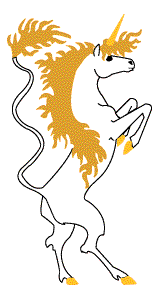| Revision as of 20:04, 14 March 2004 view sourceWetman (talk | contribs)Autopatrolled, Extended confirmed users, Pending changes reviewers, Rollbackers92,066 edits qilin reference; reverted a short section (see discussion), left dancing monkeys and symbols of Jesus etc etc...← Previous edit | Revision as of 21:01, 14 March 2004 view source Wiglaf (talk | contribs)20,911 editsNo edit summaryNext edit → | ||
| Line 14: | Line 14: | ||
| The unicorn also served as a common symbol of purity and of ]. The traditional method of hunting unicorns involved entrapment by a ]. This is believed to stem from the method of trapping ], a creature that may have inspired some medieval accounts of unicorns, in Africa. A female ] would be taken to where the Rhinos were and would dance for them. The Rhinos would become mesmerised by the antics of the monkey and would thus be an easier target for the hunters. | The unicorn also served as a common symbol of purity and of ]. The traditional method of hunting unicorns involved entrapment by a ]. This is believed to stem from the method of trapping ], a creature that may have inspired some medieval accounts of unicorns, in Africa. A female ] would be taken to where the Rhinos were and would dance for them. The Rhinos would become mesmerised by the antics of the monkey and would thus be an easier target for the hunters. | ||
| == |
==Extinct "unicorn"== | ||
| It has been proposed that the unicorn is based on an extinct animal called '''giant unicorn''', or ], a huge ] ] with a single horn in the forehead. The relation between the two animals is uncertain, but a '''real''' giant unicorn was once seen and hunted by man; see the ] article for more. | It has been proposed that the unicorn is based on an extinct animal called '''giant unicorn''', or ], a huge ] ] with a single horn in the forehead. The relation between the two animals is uncertain, but a '''real''' giant unicorn was once seen and hunted by man; see the ] article for more. | ||
Revision as of 21:01, 14 March 2004
The unicorn is a legendary creature shaped like a horse but with a single - usually spiral - horn growing out of its forehead. It is not related to the mythical Chinese qilin ("kylin") with the body of a deer and the head of a lion.

According to an interpretation of seals with an animal which resembles a bull (and which may in fact be a way of depicting bulls in profile), it has been claimed that the unicorn was a common symbol during the Indus Valley Civilisation, appearing on many seals. It may have symbolised a powerful group.
In German since the 16th century, the name unicorn (einhorn) has become attached to the various rhinoceros. The unicorn does not appear in early Greek mythology, but the Greeks later regarded the unicorn as a real animal that lived in India.
In medieval times Narwhal tusks, however, provided the main source of "unicorn" horns.
In popular belief, unicorn horns could neutralize poisons. Therefore, people who feared poisoning sometimes drank from goblets made of "unicorn horn". Alleged aphrodisiac qualities and other purported medicinal virtues also drove up the cost of "unicorn" products such as milk, hide and offal. Unicorns were also said to be able to determine whether or not a woman was a virgin; in some tales, they could only be mounted by virgins.
The unicorn also served as a common symbol of purity and of Jesus Christ. The traditional method of hunting unicorns involved entrapment by a virgin. This is believed to stem from the method of trapping Rhinos, a creature that may have inspired some medieval accounts of unicorns, in Africa. A female monkey would be taken to where the Rhinos were and would dance for them. The Rhinos would become mesmerised by the antics of the monkey and would thus be an easier target for the hunters.
Extinct "unicorn"
It has been proposed that the unicorn is based on an extinct animal called giant unicorn, or elasmotherium, a huge Eurasian rhinoceros with a single horn in the forehead. The relation between the two animals is uncertain, but a real giant unicorn was once seen and hunted by man; see the Elasmotherium article for more.
Heraldry
The unicorn also functions as a national symbol of Scotland and appears on many British symbols, notably as a supporter of coats of arms.
In fantasy fiction, a unicorn often has magical qualities or powers. A unicorn appears in the Harry Potter series.
The constellation Monoceros represents a unicorn.